Black-colored birds are one of the prettiest and most elegant in the world.
Despite some considering them to be a bad omen, their elegance and charm can’t be denied. And some of those charming birds can grow to impressive sizes.
Examples of big black birds include the Californian condor, Andean condor, anhinga, double-crested cormorant, black vulture, black swan, common black hawk, and many others.
The biggest black bird in North America is the Californian condor with a wingspan of over 9.5 feet, while the biggest black flying bird in the world is the Andean condor with a wingspan of up to 10.8 feet.
Here are their photos and fun facts.
Table of Contents
Big Black Birds
| Black Birds | Wingspan | Length | Weight |
| Pied Currawong | 22-30 in | 17-20 in | 0.7 lb |
| White-winged Scoter | 31.5 in | 19-24 in | 2.1-4.7 lb |
| Rook | 32-39 in | 17-18 in | 0.6-0.75 lb |
| American Crow | 33-39 in | 16-21 in | 0.7-1.4 lb |
| Pelagic Cormorant | 39 in | 25-35 in | 3.3-5.3 lb |
| Anhinga | 45 in | 35 in | 2.3-3 lb |
| Double-crested Cormorant | 45-48 in | 28-35 in | 2.6-5.5 lb |
| Common Black Hawk | 48-50 in | 17-21 in | 2 lb |
| Common Raven | 45-51 in | 21-26 in | 1.5-4.4 lb |
| Rhinoceros Hornbill | 60 in | 31-35 in | 4.5-6.5 lb |
| Black Stork | 57-61 in | 37-39 in | 6.6 lb |
| Great Cormorant | 47.5-63 in | 27.5-40 in | 3.3-11.7 lb |
| Lesser Yellow-headed Vulture | 59-65 in | 21-26 in | 2.1-3.4 lb |
| Black Vulture | 52-66 in | 22-29 in | 3.5-6.6 lb |
| Greater Yellow-headed Vulture | 65-70 in | 25-30 in | 3.6 lb |
| Southern Ground Hornbill | 47-70.8 in | 35-51 in | 4.9-13.7 lb |
| Turkey Vulture | 63-72 in | 24-32 in | 1.8-5.3 lb |
| Black Swan | 63-79 in | 43-59 in | 8.2-19.8 lb |
| Southern Cassowary | n/a | 50-67 in | 129-187 lb |
| Great Frigatebird | 81-91 in | 33-41 in | 2.7-3.5 lb |
| Magnificent Frigatebird | 85-96 in | 35-49 in | 2.4-3.5 lb |
| Steller’s Sea Eagle | 77-98.5 in | 33.5-41.3 in | 10.8-20.9 lb |
| Californian Condor | 98-118 in | 43-55 in | 15-31 lb |
| Andean Condor | 111.5-130 in | 39-51 lb | 22-33 lb |
| Common Ostrich | 79 in | 82.7-110.2 in | 139–320 lb |
Pied Currawong
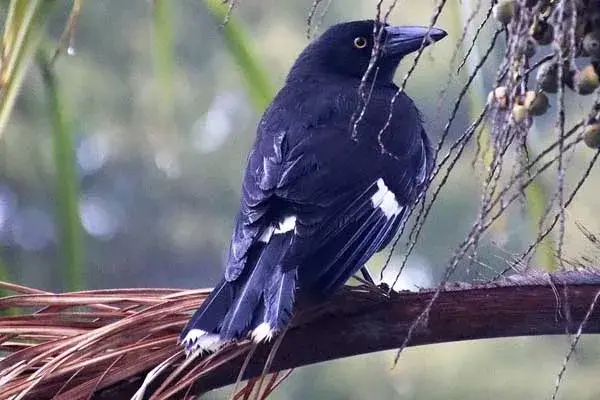
Scientific Name: Strepera graculina
Lifespan: up to 20 years
Wingspan: 22-30 in
Length: 17-20 in
Weight: 0.7 lb
Pied currawongs are black passerine birds with large black beaks and yellow eyes. These sizeable birds are native to eastern Australia and Lord Howe Island.
Pied currawongs are completely black with white color on the wings, undertail coverts, the base, and the tip of the tail. There are 6 subspecies currently recognized.
These black birds can grow up to 20 inches in length, have a wingspan of up to 2.5 ft, and weigh around 11 oz.
They are omnivorous and opportunistic feeders – they consume fruit and berries and prey on small lizards, insects, and caterpillars.
Pied currawongs got their name from a call that sounds a bit like “curr-a-wong.”
The female is responsible for building the nest high in the trees, producing a clutch of three pink-brown eggs.
White-winged Scoter

Scientific Name: Melanitta deglandi
Lifespan: up to 18 years
Wingspan: 31.5 in
Length: 19-24 in
Weight: 2.1-4.7 lb
White-winged scoters are the biggest scoter species in the world. These large black sea ducks can grow over 4.7 pounds heavy and have an average wingspan of over 2.6 feet.
Males have a distinctive knob at the base of their beaks – their necks are thick and their heads have sloping foreheads. Adult males also have silken black overall plumages with large white patches on the wings – this is visible during flight, not so much when the bird is resting.
White-winged scoters are common around freshwater lakes and wetlands in the northwestern parts of North America. They will spend winter on the Great Lakes, the coasts of the northern United States, and the southern coasts of Canada.
These large waterbirds are omnivores that feed mostly on mollusks, crustaceans, fish, insects, and some plants.
Because of their large size, white-winged scoters can dive over 65 feet to find larger prey.
White-winged scoters are also monogamous and stay together for life.
Rook
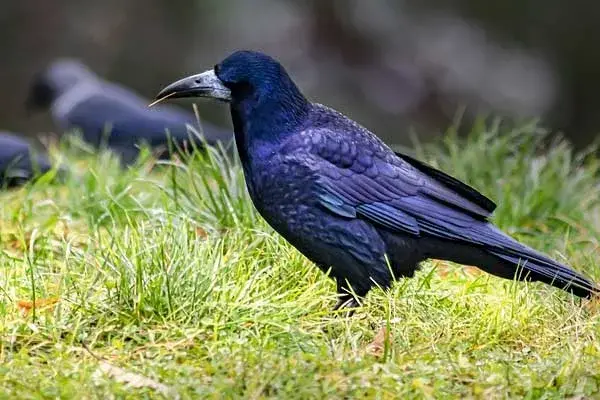
Scientific Name: Corvus frugilegus
Lifespan: 6 years
Wingspan: 32-39 in
Length: 17-18 in
Weight: 0.6-0.75 lb
Highly social and quite intelligent, rooks are large, gregarious, and black-colored birds that have for centuries been considered a bird of both good and bad omen.
The black feathers of the head, neck, and shoulders are dense and silky and will have a bluish-purple sheen in bright sunlight.
Rooks are similar in size to crows but tend to stay away from cities and towns.
They mate for life, and both sexes will build a nest of twigs, sticks, dry grass, and dead leaves.
Rooks are omnivores and feed on earthworms, small lizards, frogs, bird eggs, and seeds.
A group of rooks is called building, parliament, clamor, and storytelling.
American Crow
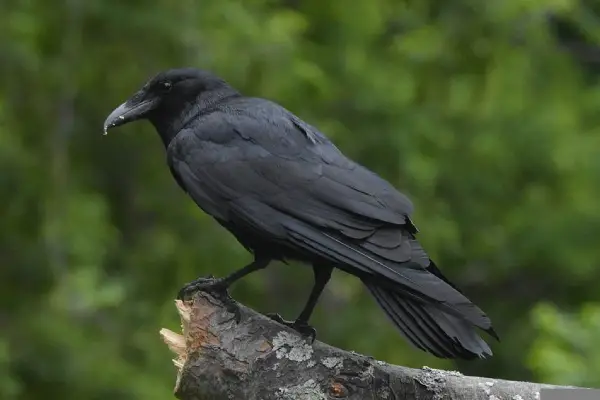
Scientific Name: Corvus brachyrhynchos
Lifespan: 7-8 years in the wild
Wingspan: 33-39 in
Length: 16-21 in
Weight: 0.7-1.4 lb
Commonly found throughout the United States, American crows are large black birds with black beaks that can measure up to 21 in length, have a wingspan of up to 39 in, and weigh almost 22 oz.
Males tend to be larger than females.
American crows are easy to recognize by their iridescent all-black color, large bills, and loud, short, and rapid “caaw-caaw” calls.
Often associated with trickery and death, they are very intelligent birds that can even use and modify tools.
They can be often seen holding “funerals” – when one crow discovers a dead one, it will call others. Groups of crows will gather, spend 10 to 15 minutes around the cadaver, and disperse and fly off silently.
These black birds are omnivores and feed on earthworms, insects, other small animals, seeds, fruit, even garbage, and carrion.
American crows are common birds in Florida’s woods and urban areas.
Pelagic Cormorant

Scientific Name: Urile pelagicus
Lifespan: up to 18 years
Wingspan: 39 in
Length: 25-35 in
Weight: 3.3-5.3 lb
These large seabirds with long necks and tails are also known as Baird’s cormorants.
Adult pelagic cormorants have all-black plumage with a metallic iridescence during the non-breeding season, long thin beaks, and large black webbed feet. When the breeding season comes, they will develop two short crests.
Males and females look similar, though males tend to be a bit bigger.
In North America, pelagic cormorants are widespread along the Pacific coast and breed from California all the way to the Aleutian Islands and the west coast of Alaska.
These large black birds can dive up to 140 feet underwater to catch prey and stay there for two minutes.
Pelagic cormorants are carnivores that feed on fish and small crustaceans (shrimp, in particular).
Anhinga
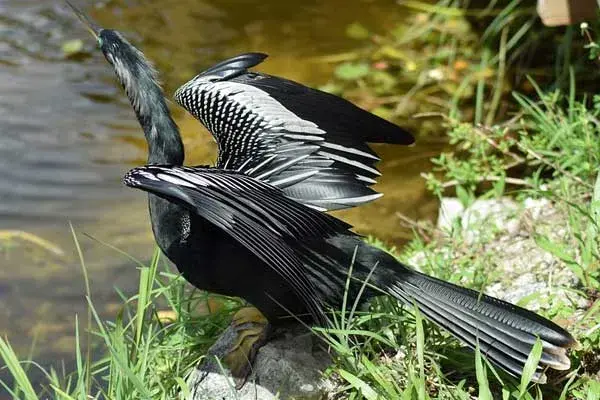
Scientific Name: Anhinga anhinga
Lifespan: 12 years
Wingspan: 45 in
Length: 35 in
Weight: 2.3-3 lb
Anhingas are large and glossy black waterbirds commonly found around lakes, freshwater marshes, ponds, and canals.
They are also known as snakebirds, darters, or water turkeys.
The name anhinga comes from the Brazilian Tupi language and means “devil bird” or “snake bird”. While swimming, only their necks appear above water, making them look like snakes, hence the name snakebird.
You will recognize males by their black plumage with white spots on their wings and backs. Females look similar but have brownish necks and heads.
Anhingas do not have waterproof wings as other birds do and can be often seen drying their feathers in the sun.
They are carnivores that feed on fish, insects, shrimp, crayfish, and sometimes even young alligators and snakes. Anhingas hunt by spearing fish and other small prey with their sharp and slender bills.
They are often mistaken for double-crested cormorants, another member of our list of big black birds.
Double-crested Cormorant

Scientific Name: Phalacrocorax auritus
Lifespan: 6-17 years
Wingspan: 45-48 in
Length: 28-35 in
Weight: 2.6-5.5 lb
These large waterbirds are common around bays, lakes, ponds, canals, and marshes.
Double-crested cormorants are the most widespread cormorant species in North America and can be recognized by their small heads, long necks, and thin, strongly hooked orange beaks.
When the breeding season starts, bushy white eyebrows (feathery tufts) will appear on a male cormorant’s head.
- Read More: 20+ birds with “eyebrows” on their heads
Just like anhingas, double-crested cormorants do not have fully waterproof feathers and can be seen standing on the shore, with their wings spread to dry.
These large all-black birds are excellent swimmers and dive over 24 feet in depth and stay there for over a minute.
The oldest documented wild double-crested cormorant lived to be almost 18 years old.
Common Black Hawk

Scientific Name: Buteogallus anthracinus
Lifespan: up to 13 years
Wingspan: 48-50 in
Length: 17-21 in
Weight: 2 lb
Common black hawks are bulky coal-black raptors with small white marks under their wings.
They are almost always found near water, hunting low and even wading in the water at times.
Common black hawks arrive in the United States around March, stay over the summer, and depart in September and October.
They are sexually dimorphic – the females are larger than the males.
Both sexes exhibit the same coloration: they have a coal-black head, body, and wing coverts and white marks at the base of the outer two or three primaries on the parts of the underwings.
They are carnivores that feed on snakes, frogs, fish, young birds, eggs, and some crabs. Usually, they hunt together with their partner, flying together and stalking their prey from above.
Common Raven

Scientific Name: Corvus corax
Lifespan: 10-15 years in the wild
Wingspan: 45-51 in
Length: 21-26 in
Weight: 1.5-4.4 lb
With a wingspan of 4 feet 3 inches and a weight of up to 4.4 pounds, common ravens are one of the biggest and heaviest songbirds.
They are found in open and forest habitats across the US and can be identified by their large size, big and curved beaks, long tails, dark brown eyes, and black iridescent color.
Common ravens are large black birds that look like crows but are much bigger and can weigh more than four times.
They have one of the largest brains of all birds. These big black birds are very intelligent; they display great ability in problem-solving, using tools, planning for the future, and even playing games like hide-and-seek.
They will also pretend to put the food in one place while hiding it in another.
Common ravens are omnivores and feed on almost anything; they will consume carrion, insects, cereal grains, berries, fruit, small animals, nesting birds, and food waste.
Rhinoceros Hornbill
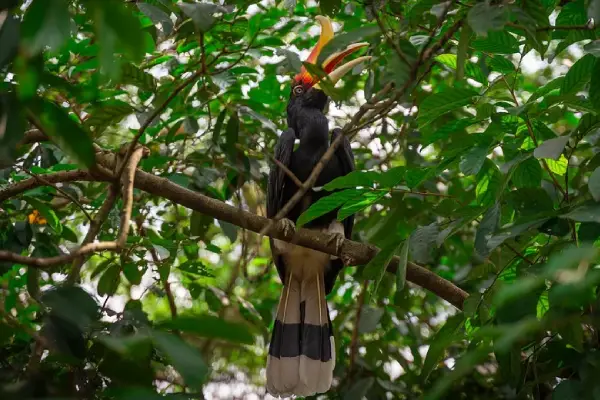
Scientific Name: Buceros rhinoceros
Lifespan: up to 35 years in captivity
Wingspan: 60 in
Length: 31-35 in
Weight: 4.5-6.5 lb
Rhinoceros hornbills are big black birds that can grow almost 3 feet long and live over 35 years in captivity. They are one of the largest birds in the rainforests of Asia.
They have mostly black plumage, white legs, red eyes, and white tails. Rhinoceros hornbills are hard to miss due to their huge orange-red beaks and casques.
Those casques are made of the same material our nails are made of (keratin) and are used to amplify the birds’ calls.
These black birds are omnivores and feed on fruit, some insect, small reptiles, rodents, and even some smaller birds.
Native Dayak people of Borneo consider rhinoceros hornbills as the chiefs of birds or the supreme worldly birds; they are also state birds of the Malaysian state of Sarawak.
Rhinoceros hornbills are monogamous and usually pair for life.
Black Stork

Scientific Name: Ciconia nigra
Lifespan: up to 36 years in captivity
Wingspan: 57-61 in
Length: 37-39 in
Weight: 6.6 lb
Black storks are large black birds with sturdy builds and a wingspan of over 5 feet.
They can weigh up to 6.6 pounds and adult black storks are easy to recognize by their mainly black plumage, white underparts, long red legs, and their long pointed red bills. Males are slightly larger than females.
Black storks are commonly found around woodlands and wetlands of Europe, Asia, and Africa.
A rather shy and cautious species that tend to avoid humans, black storks can be mostly found alone or in pairs. They nest in large forest trees, large boulders, or under overhanging ledges in mountainous areas.
Black storks are carnivores that feed on fish, insects, and amphibians. They can be often seen wading slowly in shallow waters, stalking their prey.
These huge wading birds fly with their necks outstretched.
Black storks are seasonally monogamous, they stay with their partner during the breeding season. Both parties will build the nest and take care of the young.
Great Cormorant
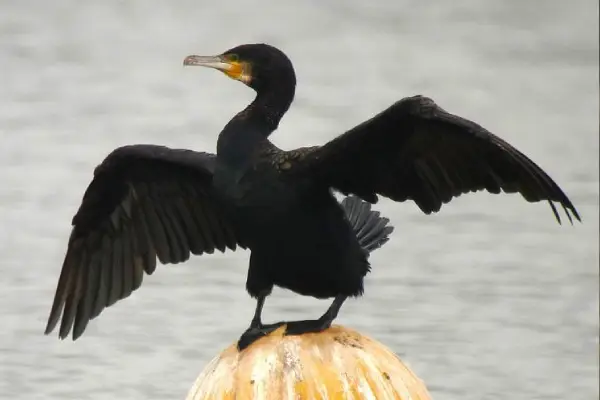
Scientific Name: Phalacrocorax carbo
Lifespan: up to 22 years
Wingspan: 47.5-63 in
Length: 27.5-40 in
Weight: 3.3-11.7 lb
Great cormorants are large black birds that can weigh over 11 pounds and have a wingspan of over 5 feet.
Males are usually bigger than females and have long thick necks, blocky heads, and hooked beaks. Great cormorants also have short legs, fairly long tails, and broad wings.
They are among the largest species of cormorants that also have black plumage, white throats, and yellowish skin around their beaks.
Great cormorants are also known as great black cormorants and are excellent swimmers. They will dive underwater and pursue their prey using their feet instead of wings.
These largest North American cormorants can be seen along the Atlantic Coast during the nonbreeding season.
Great cormorants are carnivores and primarily feed on fish, and some crustaceans, amphibians, and insects.
Lesser Yellow-headed Vulture
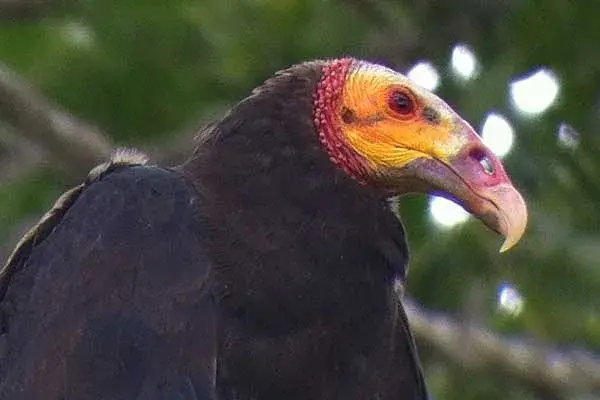
Scientific Name: Cathartes burrovianus
Lifespan: n/a
Wingspan: 59-65 in
Length: 21-26 in
Weight: 2.1-3.4 lb
The lesser yellow-headed vulture is a large black bird with a yellow head that can be found in Mexico and Central and South America.
It is also known as the savannah vulture and is common around savannas, wetlands, and other open areas.
Lesser yellow-headed vulture can be recognized by its black plumage with a green sheen, a yellow featherless head and neck, and red eyes. The eye has a single incomplete row of eyelashes on the upper lid and two rows on the lower lid.
It looks similar to the greater yellow-headed vulture – the main differences include the greater vulture’s bigger size, its yellow tinge of the head, and its darker plumage.
The lesser yellow-headed vulture is a scavenging raptor that uses its keen sense of smell to locate food. It mostly feeds on carrion, but might also hunt for food, especially small aquatic animals in marshes.
Lesser yellow-headed vulture does not build a nest but lays its eggs on the ground, cliff ledges, caves, or tree hollows. It has a clutch of two cream-colored eggs with brown and gray spots.
Black Vulture

Scientific Name: Coragyps atratus
Lifespan: 10 years in the wild
Wingspan: 52-66 in
Length: 22-29 in
Weight: 3.5-6.6 lb
Black vultures are aggressive large birds of prey that have black plumage, naked black heads, chalky white feet and legs, and white wing patches that can be seen during flight. Both sexes look similar.
They are often mistaken for turkey vultures; the main difference is the bigger size and wider wings and tails in turkey vultures. In addition, black vultures flap their wings more frequently when flying.
Black vultures are highly gregarious birds and might form large communal roosts at night that can often include turkey vultures.
They are carnivores and primarily feed on carrion; black vultures may also hunt and eat small reptiles, birds, and mammals. They will spend most of their day looking for food.
To escape from danger, these large black birds will regurgitate partially digested food to distract the attacker and become lighter before flying away.
Black vultures are monogamous and pairs are believed to mate for life – both the male and female will take turns incubating their eggs.
Black vultures are protected under the Migratory Bird Treaty Act and you can’t kill them without a permit.
They are common birds of Central Texas, Central Florida, East Tennessee, and West Pennsylvania.
Greater Yellow-headed Vulture

Scientific Name: Cathartes melambrotus
Lifespan: n/a
Wingspan: 65-70 in
Length: 25-30 in
Weight: 3.6 lb
The greater yellow-headed vulture is a dark glossy black bird with a deep yellow head. Commonly found in South America, it was once considered the same species as the lesser yellow-headed vulture.
The greater yellow-headed vulture is primarily found in the Amazon Basin of tropical South America, in undisturbed tropical forests and heavily forested areas where this large bird can take shelter.
It is also known as the forest vulture, and just like the lesser yellow-headed vulture, it feeds on carrion located using its strong sense of smell.
Greater yellow-headed vultures are quiet, and rarely engage in aggressive behavior while feeding close to each other, and other vulture species. These birds are often found solitary or in pairs, rarely in groups, except when they find a carcass.
Read More: Black-colored birds with red wings
Southern Ground Hornbill

Scientific Name: Bucorvus leadbeateri
Lifespan: 40-50 years
Wingspan: 47-70.8 in
Length: 35-51 in
Weight: 4.9-13.7 lb
With a wingspan of almost 6 feet, these enormous black birds with red necks are the largest species of hornbill in the world.
Southern ground hornbills have distinctively large, down-curved beaks they use to catch small animals found in the grasses and shrubs.
Adult males have black color and vivid red patches of bare skin on the face and throat while females have blue coloration on their throats.
They are commonly found in Southern Africa and inhabit both woodlands and savannas.
As the name suggests, southern ground hornbills will stay most of their time on the ground. They can fly but still spend around 70% of their day walking.
Southern ground hornbills are apex predators that hunt reptiles, frogs, snails, insects, and hare-sized mammals.
In the early morning, the song of these red-necked birds can be heard from miles away, with pairs singing in a duet with a deep-bass booming “oooh..oooh..ooh-oh” sounds.
Southern ground hornbills are long-lived species that can live up to 70 years in captivity.
Read More: 16+ beautiful birds with red necks
Turkey Vulture
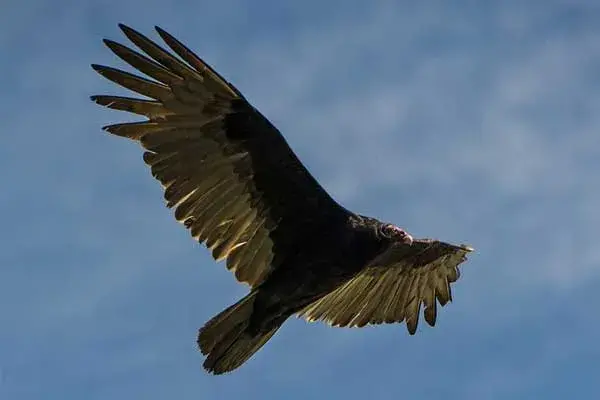
Scientific Name: Cathartes aura
Lifespan: 16 years
Wingspan: 63-72 in
Length: 24-32 in
Weight: 1.8-5.3 lb
These big black birds are the most widespread of the New World vultures. Turkey vultures, also known as turkey buzzards, or just buzzards, got named for their resemblance to wild turkeys.
With a wingspan of around 6 feet, black-brown plumage, bare red heads, and white legs, turkey vultures are hard to miss in the sky. Look for their silvery flight feathers that are contrasted with dark wing linings while they fly.
Using their keen vision and sharp sense of smell, turkey vultures can locate carrion easily. They lack a syrinx (the vocal organ) which makes them voiceless; all turkey vultures can do is hiss, whine, and grunt.
They are one of the largest raptors in the USA, just after the eagles and condors.
Some wildlife experts estimate a population of over 18 million turkey vultures in total.
They are very social birds that roost in large community groups with several hundred individuals.
You might also spot them sitting in trees on the sides of roads waiting for their next meal. They do a great service across the US by removing dead animals and preventing the transmission of any diseases those dead animals could have carried.
Because of their extremely strong stomach acids, turkey vultures can eat and digest carcasses tainted with anthrax, tuberculosis, and rabies, without getting sick.
Unlike black vultures, turkey vultures rarely hunt, but might occasionally attack a small snake or mammal.
Black Swan
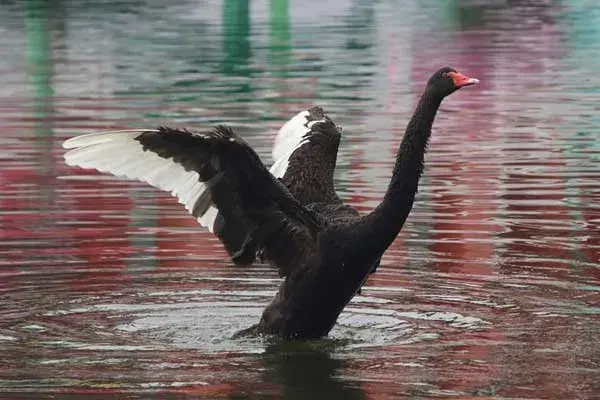
Scientific Name: Cygnus atratus
Lifespan: up to 40 years
Wingspan: 63-79 in
Length: 43-59 in
Weight: 8.2-19.8 lb
These completely black-colored birds are commonly found in Australia, Europe, and North America.
Black swans are large waterbirds that can be recognized by their red beaks, completely black plumage, and white wings with extensive bright flight feathers when flying.
Swans have far more neck bones than mammals – 24 or 25 vertebrae compared to only 7 of most mammals (giraffes also have 7 bones in their necks).
While breeding and nesting, black swans are known for crooning, making a soft singing and humming sound. They are monogamous, stay together for life, and according to a 2004 study, have a divorce rate of only 6%.
They will also use only one leg while swimming, tucking the other above their tails. Black swans are herbivores and feed on algae and weeds.
Southern Cassowary
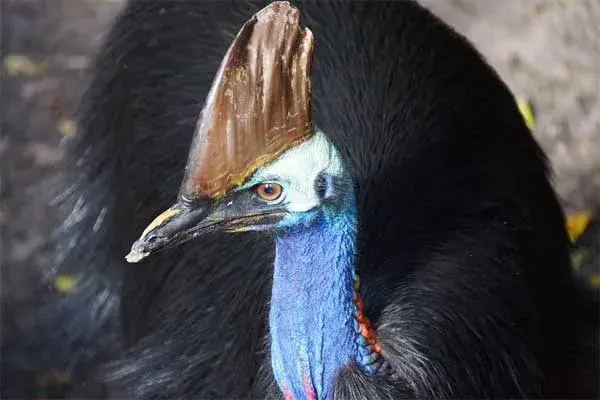
Scientific Name: Casuarius casuarius
Lifespan: 20-40 years
Wingspan: n/a
Length: 50-67 in
Weight: 129-187 lb
Southern cassowaries are huge prehistoric-looking birds with glossy black plumage, tall, brown casques (helmets) on top of their deep blue heads, and long drooping red wattles.
Their habitat mostly includes tropical rainforests, and occasionally savannah forests of Indonesia, Papua New Guinea, and northeastern Australia.
Southern cassowaries can’t fly as they have extremely small wings. However, they can grow almost 6 ft tall and weigh up to 187 pounds, which is why they belong on this list.
Southern cassowaries are the third heaviest bird in the world, after the Somali and common ostrich.
They are one of the closest relatives of the dinosaurs, as well.
Wildlife biologists call cassowaries the world’s most dangerous birds; they have killed people with their sharp 5-inch-long claws.
Southern cassowaries are omnivores that mainly feed on fruit, berries, fungi, rodents, snails, lizards, and occasionally their poop (it is made of half-digested fruit which has nutritional value).
These black and blue birds can also eat up to 11 pounds of fruit a day!
Great Frigatebird
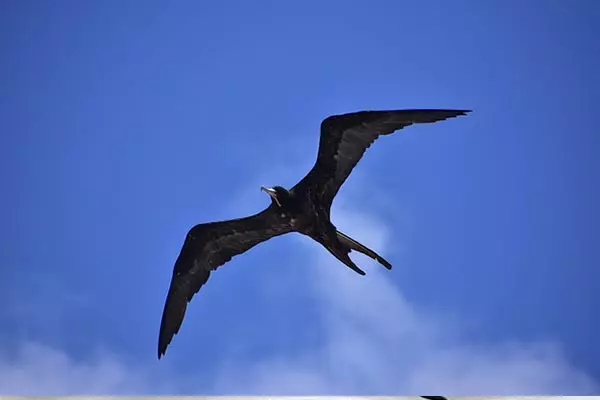
Scientific Name: Fregata minor
Lifespan: up to 40 years
Wingspan: 81-91 in
Length: 33-41 in
Weight: 2.7-3.5 lb
Great frigatebirds are all-black, have bright red “necks”, long slender wings, and deeply forked tails that appear pointed when folded. Females are bigger than males and have white throats and breasts.
These large black seabirds have the highest ratio of wing area to body mass and the lowest wing loading of any bird.
Males are well-known for their red throat “gular” sacs, which they inflate like red balloons to attract females. As part of the courtship ritual, great frigatebirds will also clatter their beaks, wave heads and wings, and males will call to females while flying overhead.
Great frigatebirds are seasonally monogamous and stay together for a season.
These black birds with red necks are rather cheeky and will often steal fish and other food from other seabirds. They will chase and harass other birds, make them regurgitate their food, and then swoop in and catch the food in the air.
If you are interested, feel free to check our examples of the world’s largest red birds.
Magnificent Frigatebird
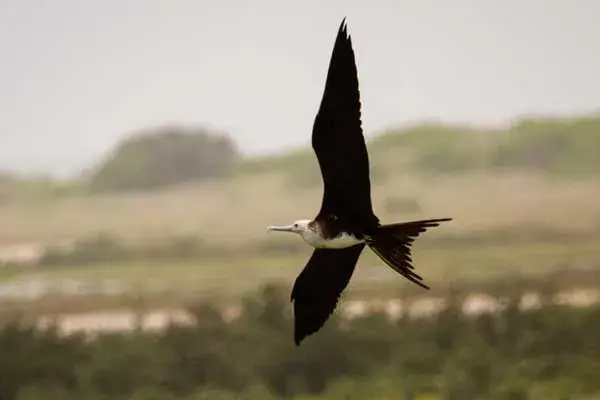
Scientific Name: Fregata magnificens
Lifespan: 14-30 years
Wingspan: 85-96 in
Length: 35-49 in
Weight: 2.4-3.5 lb
With a length of almost 4 feet and a wingspan of up to 8 feet, magnificent frigatebirds are the largest species of frigatebird.
In North America, they are most commonly found in Florida.
Rightfully named magnificent due to their striking appearance and behavior, these frigatebirds are easily recognizable even at long distances.
They have a huge size, long pointed wings, and long deeply forked tails. Males have a striking red gular sac which they inflate to attract slightly larger females. Females have white bellies.
They mostly feed on fish taken in flight from the ocean’s surface and their favorite food is flying fish, tuna, and squid. Just like the great frigatebirds, magnificent frigatebirds will also harass and steal fish from other animals. This is known as kleptoparasitism.
Despite their massive wingspans, these birds can’t land on water as their feathers aren’t waterproof and they would most likely drown.
Steller’s Sea Eagle
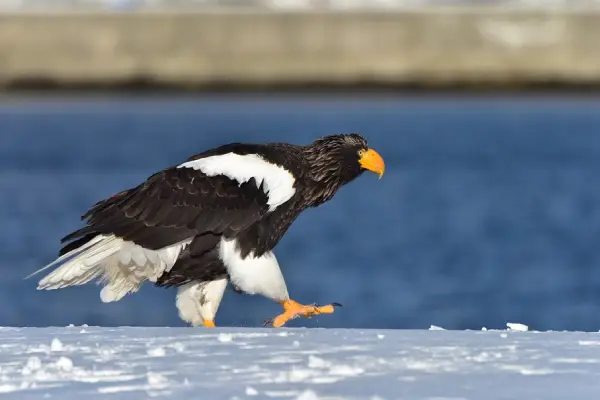
Scientific Name: Haliaeetus pelagicus
Lifespan: 20 years
Wingspan: 77-98.5 in
Length: 33.5-41.3 in
Weight: 10.8-20.9 lb
Also known as the Pacific sea eagle or the white-shouldered eagle, the Steller’s eagle is a huge bird of prey endemic to Northeast Asia.
Steller’s sea eagle is one of the largest raptors in the world. And similar to other raptors, females are bigger than males.
With a wingspan of over 8 ft, the Steller’s sea eagle has one of the largest wingspans of any living eagle. And with a weight of almost 21 pounds, it is the heaviest known eagle.
Mature adults are mostly brown-black and have large heads and massive orange-yellow beaks and talons. These birds are also easy to spot by their white foreheads, shoulders, tails, and thighs.
Steller’s sea eagles got named after the 18th-century zoologist, Georg Wilhelm Steller.
Due to their enormous sizes and attractive appearances, Steller’s sea eagles are often called the world’s most magnificent birds of prey.
The International Union for Conservation of Nature (IUCN) listed it as vulnerable on its Red List of threatened species. Some experts estimate their total population to be under 5,000 birds.
They are carnivores that mostly feed on fish, and some small mammals, ducks, gulls, and carrion.
Californian Condor
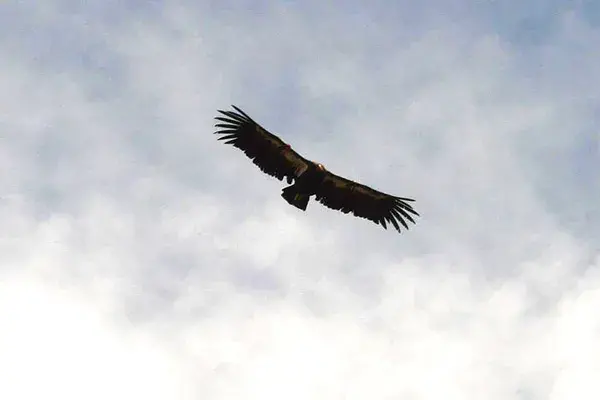
Scientific Name: Gymnogyps californianus
Lifespan: up to 60 years
Wingspan: 98-118 in
Length: 43-55 in
Weight: 15-31 lb
Californian condors are the largest North American land birds that have a wingspan of over 9.5 feet and can weigh over 30 pounds.
In 1987, there were only 27 of these birds left in the wild. Scientists captured and rereleased them around 1991.
Californian condors were slowly reintroduced in places like northern Arizona, southern Utah (including the Grand Canyon area and Zion National Park), the coastal mountains of central and southern California, and northern Baja California in Mexico.
According to the U.S. Fish & Wildlife Service, there were 537 Californian condors in the world at the start of 2022; 203 in captivity and 334 in the wild.
They are one of the world’s longest-living birds that can have a lifespan of up to 60 years.
Adult Californian condors have primarily black plumage, brilliant white triangle patches under each wing, and red or orange heads. These endangered vultures also have bald heads.
Similar to other vultures, Californian condors are scavengers that feed on the carcasses of large mammals.
Because of their strong immune system, they do not get sick from the bacteria of the decaying animals.
Californian condors can reach top flying speeds of up to 56 miles per hour, gliding at altitudes of up to 15,000 feet.
These large black birds with white under wings are monogamous and mate for life.
Want to read more about the world’s largest white birds? Check this article.
Andean Condor
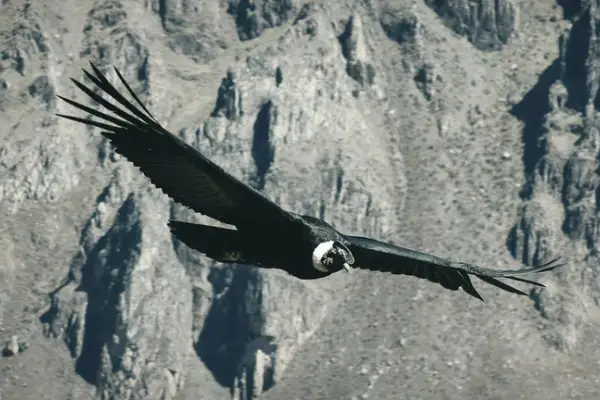
Scientific Name: Vultur gryphus
Lifespan: up to 70 years
Wingspan: 111.5-130 in
Length: 39-51 lb
Weight: 22-33 lb
With a wingspan of up to 10 ft 10 in and a weight of up to 33 pounds, Andean condors are the largest flying birds and the largest birds of prey in the world.
Adults are completely black and have a ruff of white feathers surrounding the base of their necks. Both sexes have iconic bald heads.
Males are larger than females and have large white bands on their wings and distinctive comb on top of their heads. Their eyes are brown while the females’ are red.
Andean condors have hooked beaks that are adapted for tearing carrion.
They can fly almost 180 miles per day in search of food. Andean condors are commonly found in mountainous regions and near coasts where they can use air currents to glide through the air.
They nest at elevations of up to 16,000 feet, primarily on inaccessible rock ledges. They lay one or two eggs every two years on the ground and both parents incubate the eggs and raise the young.
Andean condors have one of the world’s longest lifespans with some individuals reaching over 70 years. They are also national symbols of Bolivia, Chile, Colombia, Ecuador, and Peru, where they can be found.
Andean condors are threatened species with an estimated global population of around 10,000 individuals.
Read More: 20+ examples of small blue birds
Common Ostrich
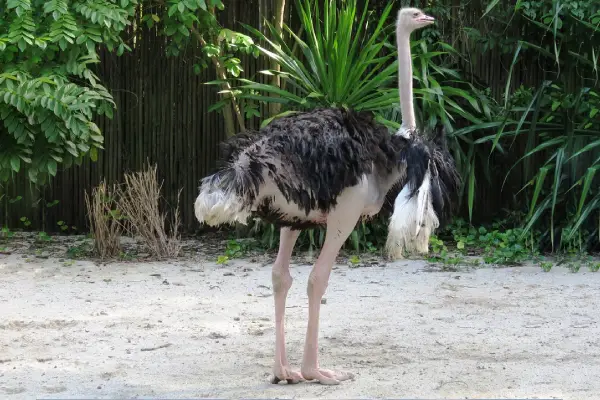
Scientific Name: Struthio camelus
Lifespan: 30-40 years in the wild
Wingspan: 79 in
Height: 82.7-110.2 in
Weight: 139–320 lb
The common ostrich is the biggest bird in the world. With a height of over 9 ft and a weight of over 300 pounds, it is also both the tallest and heaviest.
It has a distinctive appearance, a long neck, and robust legs and can reach up to 40 mph in a short burst. This makes it also the fastest land bird.
Mature males have black-and-white plumage and pinkish skin while the females are duller grayish-brown.
Common ostriches are found across African hot savannahs and open woodlands.
These flightless black birds also have huge eyes that are larger than their brains.
Ostriches also have long eyelashes that help protect their eyes from sandstorms, just like in camels, and can survive almost two weeks without water.
And contrary to popular belief, ostriches don’t bury their heads in the sand to avoid predators. They lay their eggs in the ground and need to rotate them a couple of times per day, giving the wrong head-in-sand appearance.
Read More: 16+ examples of the smallest black birds
Summary
This concludes our list of big black birds.
Examples of large black-colored birds include several types of vultures, couple types of condors, frigatebirds, and many others.
Big black birds that eat dead animals include black vultures, turkey vultures, Andean condors, ravens, and crows.
Hopefully next time you see these birds, you will recognize any of them with ease!
And if you enjoyed our article, here’s another popular read on birds: 40 examples of birds that have orange beaks and 17+ examples of huge birds of Florida